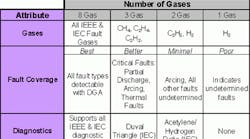In this paper released March 17, Serveron provides insight and guidance on the selection of on-line dissolved gas analysis (DGA) monitoring and diagnostic tools for utility transformers. Transformers as utility asset classes in the context of their impact on revenue, grid stability, and service reliability are examined.
Transformer Fleet Reliability
Reliable energy flow is paramount, and power transformers are critical and costly assets in the grid. As an asset class, transformers constitute one of the largest investments in a utility’s system. For this reason, transformer condition assessment and management is a high priority. Each utility’s grid is unique, and investment levels in asset condition and assessment tools varies according to risk level and investment return models.
While the models are different for each utility, the common element in them is that transformer fleets are stratified according to the criticality of individual transformers. The variability and uniqueness lies in where the prioritization lines are drawn and the investment amounts allocated for asset condition and management tools for each level. Typically this approach has the most critical transformers receiving the highest investment of condition assessment and management tools and decreases for each less critical level identified.
An intentionally simplified model below shows one approach to transformer fleet stratification:
Stratification Levels
Critical – Those transformers that, if failed, would have a large negative impact on grid stability, utility revenue, and service reliability. GSU’s and transmission transformers which are part of critical power flows are in this level
Important –Those transformers that, if failed, would have a significant negative impact on revenue and service reliability. Transmission substation transformers and major distribution substation transformers are generally in this level.
Recoverable – Those transformers that, if failed, would have low impact on revenue and reliability. These are mainly smaller distribution substation transformers.
The relevance of transformer fleet stratification is more important today than in the past. Transformers don’t last forever. In the United States, with an average age of almost 40 years, many are now approaching the end of their design life. Higher loads placed on transformers--in a market that demands more electricity--have also taken their toll on transformer longevity. Compound this with the reduction in capital budgets and the need to more closely manage transformer assets becomes essential. Utilities can avoid unplanned failures, lower maintenance costs and defer capital expenditures through the appropriate use of transformer condition assessment and management tools. Applying the right tools for the situation is what stratification is all about.
The Evolution of DGA
Monitoring the state of health of power transformers, a key component in the path of reliable power, has traditionally been carried out using laboratory DGA tests performed at periodic intervals. DGA of transformer oil is the single best indicator of a transformer’s overall condition and is a universal practice today, which got started in earnest in the 1960s.
While laboratory or (somewhat recently) portable DGA has been the traditional practice, the use of on-line DGA tools has gained in popularity. The reason for this is the need for utilities to maintain or improve their reliability in the presence of decreased capital expenditures and an aging infrastructure. Something more than periodic laboratory or portable DGA is needed to be successful in the current environment and the two approaches (on-line DGA and laboratory DGA) now co-exist at many utilities. On-line DGA helps utilities avoid unplanned failures, adopt lower cost condition-based maintenance, and defer capital expenditures by extending the transformer’s useful life.
First generation (1970s), as well as some current on-line DGA products available today, provides total combustible gas (TCG) or single gas (hydrogen) monitoring. These products provide indication of developing problems in the transformer but offer no legitimate diagnostic capability. On-line DGA offerings in the market have evolved from this early approach to include multi-gas monitors that detect and analyze some or all of the eight fault gases identified in the IEEE and IEC standards as well as provide diagnostic capability.
Newer on-line DGA products have the unique ability to continuously trend multiple transformer gases and correlate them with other key parameters such as transformer load, oil and ambient temperatures as well as customer specified sensor inputs. This capability enables utilities to relate gassing to external events, a key to meeting utility reliability and financial goals in the current environment. A study has also shown that some on-line DGA tools offer better accuracy and repeatability than laboratory DGA. This can improve the transformer asset manager’s decision timeliness and confidence when incipient faults are detected.
With the advent of on-line DGA monitoring, there has also been new learning about the nature of developing faults in transformers. On-line DGA monitoring has produced multiple case studies that document the development of critical faults, which could cause catastrophic transformer failure if left undetected, in timeframes from a few days to a few weeks. There is a low probability of capturing these rapidly developing fault conditions with a laboratory or portable-based transformer DGA testing program.
Recently, the ability to automatically populate traditional DGA diagnostic tools with on-line DGA data has appeared in the market. This new development offers users of on-line DGA monitors unprecedented insight into the nature and identification of developing faults. The tools are typically ratio-based and the on-line data set enables trending of fault gas ratios over time rather than the traditional static snapshots. Diagnostic outcomes can now be determined quickly and with more certainty than in the past. Neural network diagnostic approaches utilizing DGA data are also new to the market and promise more accurate diagnoses but have not yet been included in IEEE or IEC guides.
Selecting On-line DGA Tools
The last few years have seen a new array of DGA tools enter the market and this poses challenges for utilities to understand and choose an approach that best meets their needs. Transformer asset managers have important decisions to make based on DGA information, including whether or not to take a transformer off-line in order to avoid a catastrophic failure. These decisions can significantly affect utility service reliability and revenue. The aging infrastructure and increasing electricity demand placed on existing transformer assets is exacerbating the problem. Higher loading on older transformers is causing faults that can lead to catastrophic failure to develop faster and more often. The transformer reliability bathtub curve shows that new transformers are not immune to failure either. This puts pressure on transformer asset managers to make critical reliability and revenue decisions more quickly and more often than in the past. Each transformer asset manager must choose the amount and type of transformer condition data he requirs for each level in the stratification model to make these big decisions. In response to this need the vendor community has brought out products that better support the asset manager’s decision integrity by supplying more timely, accurate and certain transformer DGA data and diagnostic tools.
The increasing variety of on-line DGA tools, while helpful to the industry overall, presents transformer asset managers with the problem of matching the right product to their needs. A framework for decision making is required. The first step is a determination of a transformer fleet stratification model. For purposes of this paper, the stratification model already discussed will be used. To recap, the model has three levels of transformer assets identified; critical, important, and recoverable. In Table 1 below there is a list of attributes for various on-line DGA product categories relevant to on-line DGA tool selection. This list of attributes should be considered when applying on-line DGA to the various levels of a stratification model.
On-line DGA tools can be categorized by the number of gases they measure. The other attributes in the table are a direct result of the number of gases measured. Most modern on-line DGA tools offer the ability to measure other parameters such as moisture-in-oil. These other parameters are not included in the table as they are common for most offerings in the market today. Table 1 shows that the number of gases measured enables better fault coverage and diagnostic capability. These two attributes are critical decision criteria for the transformer asset manager. They define the extent of asset condition information available from the on-line DGA tool.
Fault coverage: is the number of detectable incipient fault conditions that the on-line DGA tool can support from its gas data. The fewer gases measured, the more fault conditions go undetected by the on-line DGA tool.
Diagnostics: is the capability of the DGA results to support the various diagnostic tools available in the IEEE and IEC guides. Once again, fewer gases measured mean fewer diagnostic tools available to identify fault modes. Fault coverage and diagnostics are the critical attributes that transformer asset managers should consider when choosing on-line DGA tools for the various levels in their stratification models. Price is also a consideration but the relative value of the solution, as defined by the fault coverage and diagnostic capabilities, is the more important measure. In other words, some solutions may have a higher price but the value provided (through superior transformer condition knowledge) in terms of improved utility service reliability and revenue far outweighs the higher price.
Now, let’s add the stratification model levels to Table 1, the on-line DGA tools/attributes table. This creates Table 2 which indicates the potential application of on-line DGA tools to our stratification model. This selection of on-line DGA tools for each level reflects the approach of making the highest investment in on-line DGA tools for the most critical transformers and less investment in tools for lower levels in the stratification model. Notice that this approach uses the on-line DGA tools with the most fault coverage and diagnostics for the critical and important transformers in the fleet. Utilities will find more appropriate returns on investment for their critical and important transformers with on-line DGA tools that offer good fault coverage and diagnostics capability rather than with the lowest cost, poor fault coverage tools that lack diagnostic support.
The current environment of higher loading on aging transformers, deferred capital expenditures as well as increased service reliability requirements suggests that utilities should take advantage of the improved on-line DGA offerings (i.e. better fault coverage and diagnostics) in the market to get the best protection for its biggest asset class – at all levels. Appropriate on-line DGA monitoring and diagnostic tools will help utilities avoid unplanned failures, lower maintenance costs and extend transformer useful life.


